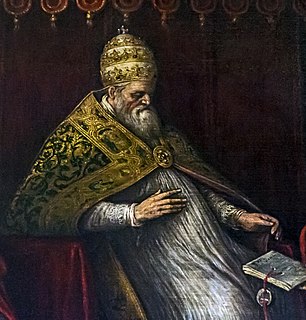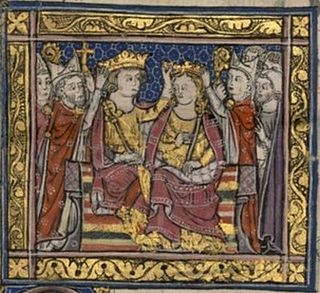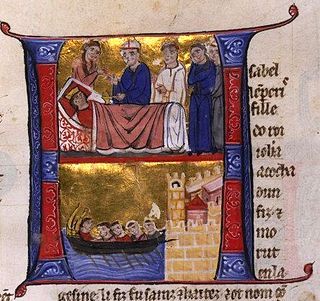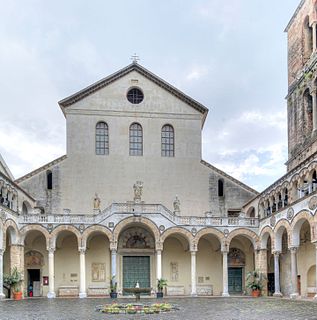Caesarius of Alagno (died 1263) was a Roman Catholic priest, bishop and royal counsellor. He served as an archdeacon in the cathedral of Sant'Andrea in his hometown of Amalfi before moving to Salerno, where he stayed with a sister before settling in Rome. In 1211 he was elected bishop of Famagusta in the Kingdom of Cyprus. In 1221, 1224 and 1225 he made trips to Rome as the procurator of Queen Alice of Cyprus. In 1225 Pope Honorius III promoted him to the archbishopric of Salerno, which had been vacant since 1221. Along with five other Sicilian bishops appointed by Honorius, he was at first unable to occupy his see on account of the opposition of the Emperor Frederick II. [1]

Amalfi Cathedral is a medieval Roman Catholic cathedral in the Piazza del Duomo, Amalfi, Italy. It is dedicated to the Apostle Saint Andrew whose relics are kept here. Formerly the archiepiscopal seat of the Diocese of Amalfi, it has been since 1986 that of the Diocese of Amalfi-Cava de' Tirreni.

Salerno is an ancient city and comune in Campania and is the capital of the province of the same name. It is located on the Gulf of Salerno on the Tyrrhenian Sea. The city is divided into three distinct zones: the medieval sector, the 19th century sector and the more densely populated post-war area, with its several apartment blocks.

Rome is the capital city and a special comune of Italy. Rome also serves as the capital of the Lazio region. With 2,872,800 residents in 1,285 km2 (496.1 sq mi), it is also the country's most populated comune. It is the fourth most populous city in the European Union by population within city limits. It is the centre of the Metropolitan City of Rome, which has a population of 4,355,725 residents, thus making it the most populous metropolitan city in Italy. Rome is located in the central-western portion of the Italian Peninsula, within Lazio (Latium), along the shores of the Tiber. The Vatican City is an independent country inside the city boundaries of Rome, the only existing example of a country within a city: for this reason Rome has been often defined as capital of two states.
Caesarius later became an avid Ghibelline (imperialist), a familiaris and counsellor of Frederick's illegitimate son King Manfred of Sicily. From Manfred he obtained the right to hold an eight-day market at Salerno during the feast of Saint Matthew, the city's patron. He augmented the archdiocese's possessions with the district of Battipaglia (confirmed by Manfred) and the castle of Olevano (confirmed by Frederick II). In January 1260 he altered the customary food allowance of the cathedral canons of Salerno, threatening violators with excommunication. He died in 1263 and was buried in the cathedral of Amalfi. His tomb lies beside the main entrance, under a marble arch. [1]
In the Middle Ages, a familiaris, more formally a familiaris regis or familiaris curiae, was, in the words of the historian W. L. Warren, "an intimate, a familiar resident or visitor in the [royal] household, a member of the familia, that wider family which embraces servants, confidents, and close associates." Warren adds that the term "defies adequate translation", but is distinct from courtier, "for the king employed his familiares on a variety of administrative tasks."

Battipaglia is a town and a comune in the province of Salerno, in the Campania region of south-western Italy. With a population of 51,032 as of 2018, it is the third most populous town of its province, after Salerno and Cava de' Tirreni.
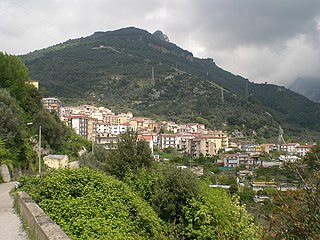
Olevano sul Tusciano is a town and comune in the province of Salerno in the Campania region of south-western Italy.

